|
|
|

|
|
|
R-Shief Blog
Interactive tools that enable users to analyze their own data. |
|
by: salty FOR IMMEDIATE RELEASE: LOS ANGELES, October 26, 2011- 3 Days, 30 Twitter hashtags, and countless ways to understand the occupy movement. From 09 December 2011 to 11 December 2011, R-Shief, a lab that collects and analyzes Middle East content from the Internet, will hold its first hackathon with satellite locations throughout the world. The aim of this event is to give activists data collected from Twitter, as well as R-Shief’s machine learning analytics, in a collective effort to offer a public and shared repository for data and visualizations about the Occupy Movements. In solidarity with protestors around the world, #OccupyData is meant to serve as an intervention by offering experts and activists means to work together and think critically about the movement, its messages, and goals. Register and receive open access to export four CSV files for each hashtag -- (1) stats by day, (2) stats by hour (3) stats by minute and the (4) raw data itself. (These files are automatically updated hourly). We encourage all participants to post links or images of the work that comes out of this to R-Shief’s blog رشيف | Blog or Visualize It section رشيف | Data Visualizations. Reports from this event will also be featured in Jadaliyya. Register @ R-Shief | #OccupyData Live graphs @ R-Shief Twitterminer More information @ https://bit.ly/occupyhackathon #OccupyData @ Twitter Hashtag Feed 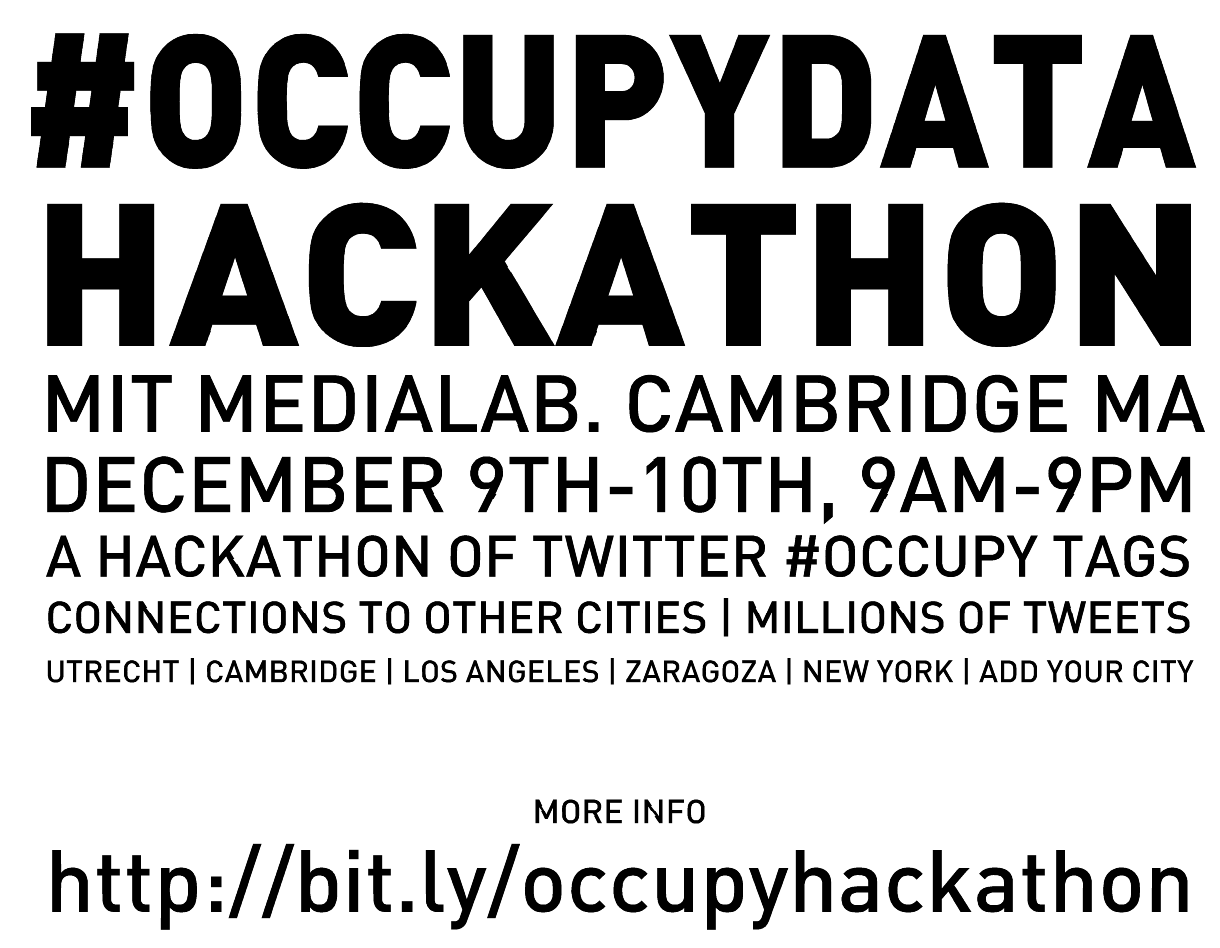 VENUES UTRECHT, NL We’ll be working out of Setup, at the Neude 5, Utrecht. We have reserved the space for three days, December 9th-11th. On December 9th, opening at 12 p.m. GMT+1. Closing on December 11th at 3 p.m. GMT+1. Article written by team in Utrecht. CAMBRIDGE, MA Friday Decembrer 9th, From 9am-9pm Eastern time. Room E14-240 Media Lab. MIT – T Station: Red line. Kendall stop. Click here for event listing. LOS ANGELES, CA Friday, December 9th – 11th, from10am-4pm Pacific time. Institute for Multimedia Literacy @ USC in the Blue Lab. 746 West Adams Blvd. Los Angeles, CA 90089 Still looking for venues in NYC, Seattle, Oxford…. *Of course, you can always just participate online.  WHAT: #OccupyData: a hackathon of Twitter #occupy tags WHEN: December 9, 2011 to December 11, 2011, 12 a.m. PST. HOSTED BY: R-Shief.org CO-SPONSORS: HaCCS Jadaliyya e-zine OccupyResearch.net USC's Institute for Multimedia and Literacy USC’s Interdivisional Media Arts and Practice Ph.D. Program STEERING COMMITTEE: Micha Cardenas, Sasha Costanza-Chock, Jeremy Douglass, Maria Garrido, A. J. Patrick Liszkiewicz, VJ Um Amel, and Jillian C. York CONTACT: Register online at R-Shief | #OccupyData Hack-a-thon Ms. Zoe Weintraub at zoe@r-shief.org 4,324 views COMMENT(S) |
|
by: Laila Occupydata, an event hosted by R-Shief.org with several co-sponsors and steering committee, created a quiet buzz within the social network and media world when R-Shief announced the opening of its #occupy tags and analytics for a 3-day hackathon. On Twitter, the number of posts that included #OccupyData rose as soon as the announcement was released on Wednesday, December 7. Out of Stanford University, @Liberationtech tweeted, "Extraordinary & Unprecedented: #OccupyData Hackathon to Bring Together Academics & Activists." Another influential tweet by Ethan Zuckerman was retweeted 44 times on December 7: "You're invited to the #OccupyData hackathon, analyzing #OWS data at @civicMIT." While the outcomes from this experimental event are proving to be more than a series of smart, useful, and beautiful data visualizations created in 48 hours, perhaps more importantly, what has emerged is systematic documentation of our process (by way of videos, notepads shared online, recorded conversations, and many backchannels). Our process also included synchronizing among four venues -- Utrecht in the Netherlands to Zaragoza, Spain to Cambridge and Los Angeles in the US. We hope the trails we leave behind will serve future research and development in the area of social networks, resistance, data visualization, social media analytics, and the occupy movement.  Fig. 1. Live graph of analytics on #OccupyData Twitter feed as we authored it. Total of 643 tweets over 14 days from November 28 – December 11, 2011. We organized this event seeking how we might apply the mechanics of the occupy movement to the data of Twitter itself? #OccupyData is meant to serve as an intervention by offering experts and activists means to work together and think critically about the movement -- how its messages, goals, the role new media, and specifically, Twitter might play in this system. Officially, 39 people registered for the event internationally to receive open access to R-Shief's collection and swarm computing analytics. Joining us on backchannels like Ustream and IRC channel were experts such as Gilad Lotan from Social Flow who, along with others, gave online advice and lectures. The pedagogical implications of this experiment are many -- bringing activists, whose learning is self-directed and modus operandi is often speed over rigor, with academics, whose reflexive methods often require time and are embedded in privileged, hierarchical systems of learning, is ambitious to say the least. In trying to tailor this event for both activist and academic audiences, some design processes failed to work cohesively. For example, the request for academic participants to “register” is both understood and gives credibility to the event within that community. However, asking hackers and activists to register intrudes into the veil of anonymity many Western activists create (i.e. Bansky and Anonymous). Within a few hours of day one of the hackathon, someone created a bit-torrent of the data that enabled users to bypass the registration process. It is made available on the Google public document that has become the centralized repository about the hackathon, being co-edited by over 25 users at once. 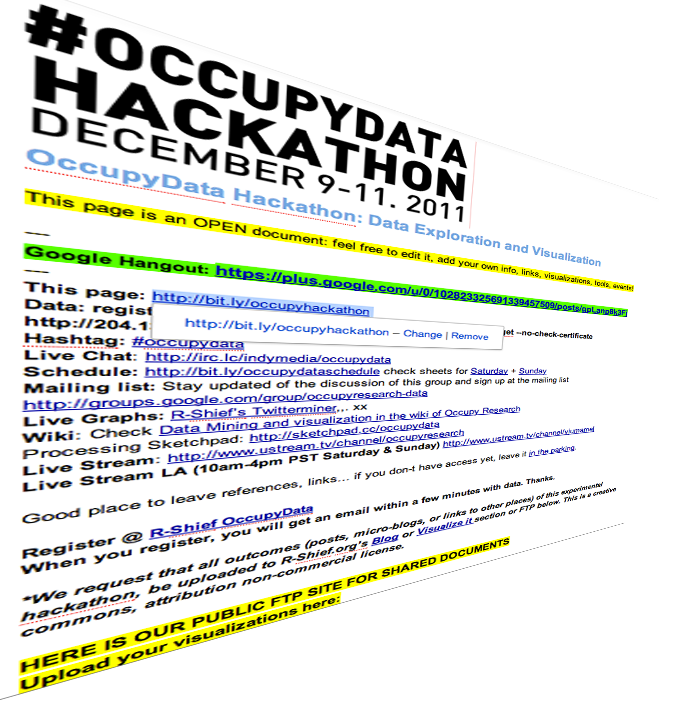 Fig. 2. Google document that was universally shared and often had 25 people logged into it at once. Contains rich list of resources for hackathon. We knew that eventually it would happen, but still wanted to see how the hacking of the registration system would unfold. The conversation about how accessible we made the database was discussed among the steering committee with rigor months before as we planned the event. Requesting each person to register in order to use the data served two purposes. One, we asked users to agree to an attribution, non-commercial licensing on the registration form. And, two, we wanted to know what would happen with the data and have a centralized location to showcase the outcomes of the event. There was another reason why we had asked people to register – and that is we are in pursuit of workable models for organizing ourselves in a post-Arab Revolution, post-OccupyWallStreet, post-Twitter world. On some levels, the information age is one of hyper-transparency, and inevitable surveillance. One tactic that we were trying to employ is a process of sousveillance – a type of inverse surveillance or "watchful vigilance from underneath.” Here is a 2 minute video I had done on the theme back in 2008: Sousveillance seems to be working in the Middle East where activists and bloggers are known not only by name, but also by face, a face that sometimes carries symbolic meaning. One of the sparks of the Egyptian revolutions was the spreading of the face of the Alexandrian who was brutally killed in 2010, Khaled Said. And, more recently, the names and faces of Egyptian activist Alaa Abd El-Fattah jailed under false charges, and Palestinian protester, Mustafa Tamimi who was killed just two days ago, are common. Not to make it sound too simplistic, but I wonder what are the cultural differences that might foster this Western anonymity and Middle Eastern hyper-transparency? Or is it visibility? Is there a difference? What is at stake for these divergent tactical methods? #OCCUPYDATA HACKATHON DAY 1 For me in Los Angeles (see #OccupyData schedule), Friday morning began very early (9 hours behind UTC in West Europe) to synchronize with fellow hackers in the Netherlands who had organized a team of students and faculty from Utrecht University’s New Media Master’s program. In a blog post about the event, Assistant Professor Mirko Schaefer wrote, “NMDC students are interested in data analysis and visualization. Popular platforms such as Twitter generate large amounts of data that can be scraped from the Internet.” Indeed, these guys (Ryanne Turenhout, Thomas Boeschoten and Ruben Hazelaar from UU) were motivated and had blown through the dataset before I actually woke up. See article. Meanwhile, the guys in Boston were arriving to the MIT Media Lab after a night when the #OccupyBoston protestors were evicted by authorities. The fast-paced “Twitter energy" was palpable as hackers tweeted each other in efforts to synchronize. By the time we started the hackathon in Los Angeles, the group in Zaragoza, Spain was giving a brilliant lecture on UStream on “Complex Systems and Networks Group of the Institute for Biocomputation and Physics of Complex Systems." Twitter research #spanishrevolution 15m 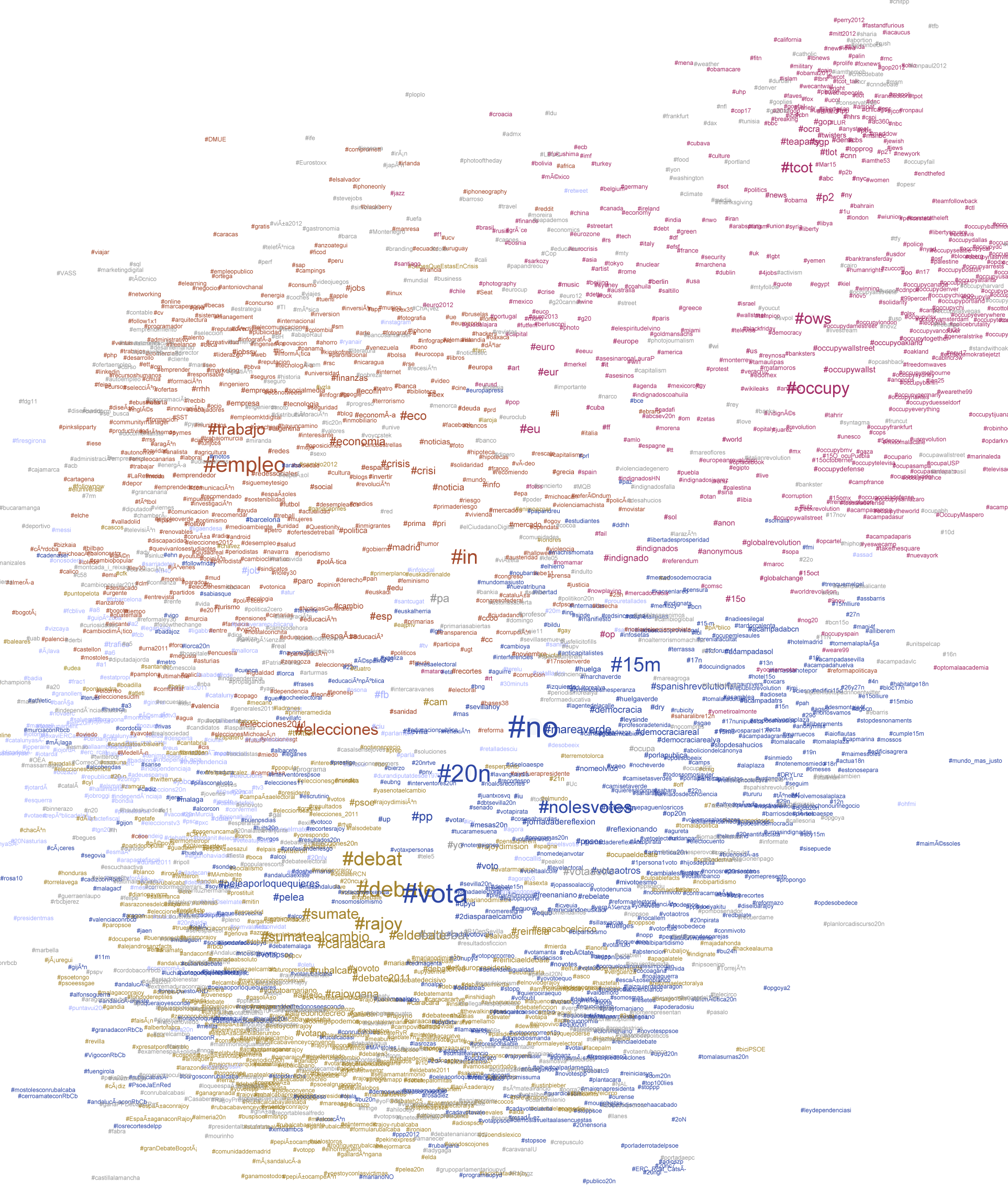 Fig. 3. This is a typical co-occurrence map of hashtags (Spanish #elections in November 2011) Meanwhile, the team in Utrecht had sent me a dropbox link to a bunch of files they had processed for network analysis using Gephi. But after doing so, they realized they had much more than they could analyze and wanted to share the files with others in the hackathon. And at the MIT Media Lab in Cambridge, Sasha Costanza-Chock, Pablo Rey, and Kawandeep had uploaded a series of images reflecting the results of their whiteboard brainstorming session.  Fig.4. The systematic documentation conducted on the Occupy Research website for the hackthon is a rich contribution. To view each image, see blog post about this Brainstorming Session. At this point, both groups had realized the broad scope of the project and decided to focus on one corpus of data. The Utrecht team focused their work on the OccupyAmsterdam tags, while the MIT team focused on the OccupyBoston tags – each making use of their local experience and knowledge. After watching the truly inspiring work presented in Spain via UStream, Alex Leavitt and myself, located in the Blue Lab of USC’s Institute for Multimedia Literacy in Los Angeles, joined the couple of participants in Cambridge and Utrecht in Google Hangout. We live streamed the conversation for other’s to watch and join in. 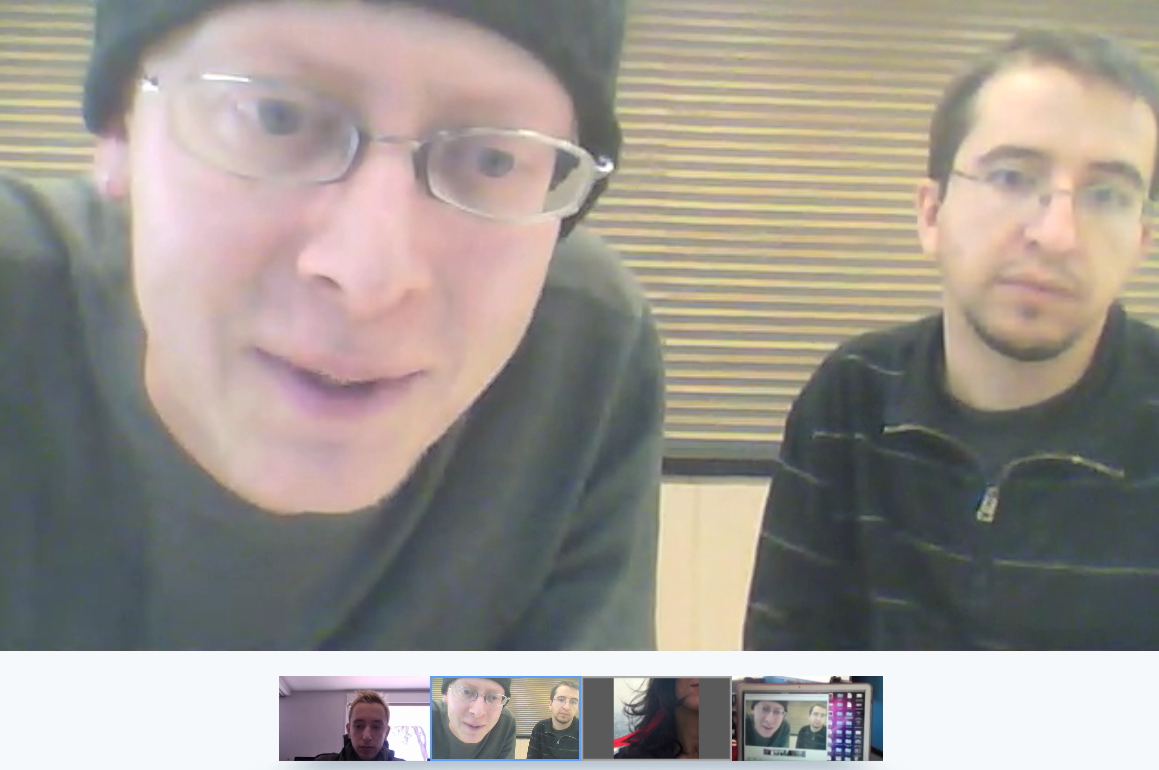 Fig. 5. Google Hangout where Sasha, Pablo, and Kawandeep were presenting their white boards. While the other teams were thinking through the various available datasets, in Los Angeles, fellow USC PhD students Alex Leavitt, Micha Cárdenas, and I engaged in long conversations around the design process of analysis – the value of qualitative versus quantitative study. We discussed the role of ethics in new models of communication and social interactions. In a post-DIY world, where are our value economies? We also spent time engaging the questions Micha posted on Twitter the night before. She asked, “#OccupyData: can we use the data to visualize the scope of violence? global num of arrests? of police? of types of arrests?” And, “can we dynamically shift qualities like size, attitude towards police, economic status 2 various qualities like color & shape?” Ultimately, “how can you visualize a mass movement of locally autonomous collectivities? Or even a single occupation?” #OCCUPYDATA HACKATHON DAY 2 On day two, we started seeing visuals and more documentation emerge. The morning began with several people using pad.riseup to make choices about what scripts, and software to use in various visualizations. We were able to both collaborate on decisions as well have preserved documentation of that process. See Occupy LinkViz first steps |Occupy Research. 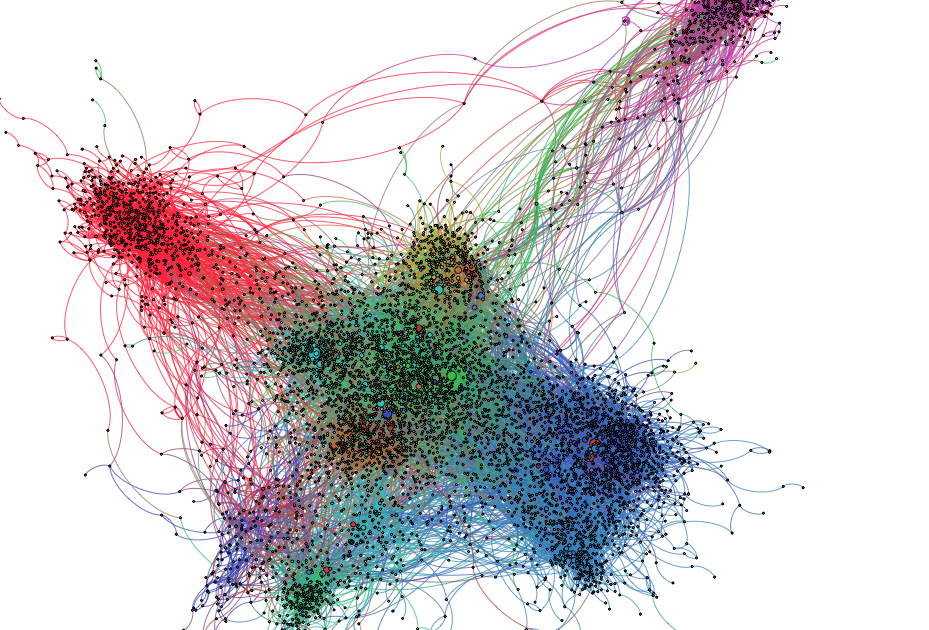 Fig. 6. For explanation of iterations and for documentation, see Ryanne Turenhout's post on Visualizing 14 @reply hashtag networks visualised in Gephi]Visualising 14 hashtag networks #OccupyData | rlturenhout Also, here is a follow-up article the Utrecht team co-authored on Day 3, #OccupyData Hackathon. Analysing millions of tweets. 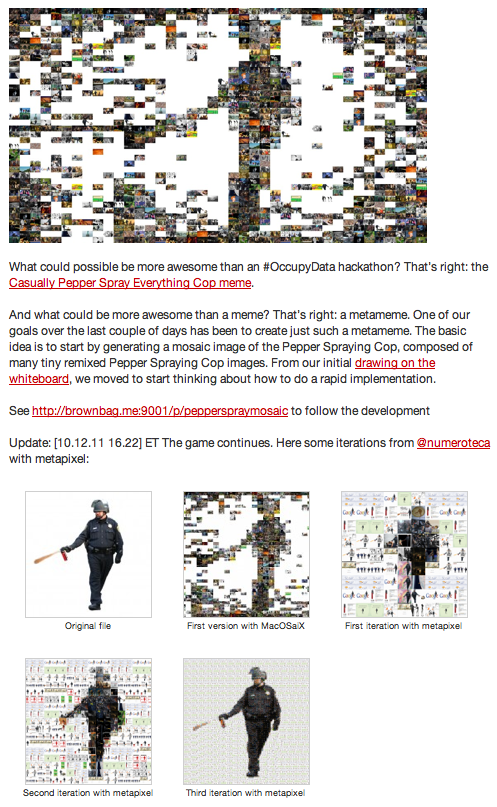 Fig. 7. For explanation of iterations and for documentation, see Pablo Rey's post on Metameme: Pepper Spray Cop Mosaic | Occupy Research Fig. 8. This graph indicates the total number of participants an number of tweets used in this #OccupyData hackathon. For documentation, see number of #OWS Participants in Twitter |Occupy Research 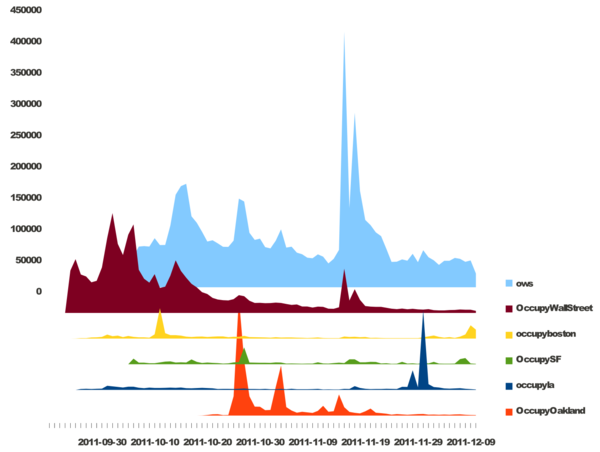 Fig. 9. This project is basically a free/libre open source implementation of trendistic. We started with the following sketch of Tweet volume by city, displayed in parallel. From there, Pablo used inkscape and libreoffice to create the following static mock-up, using the real data from the #OccupyData dataset from r-shief.org. Documentation: Occupy Hashtag Timeline Visualization|Occupy Research 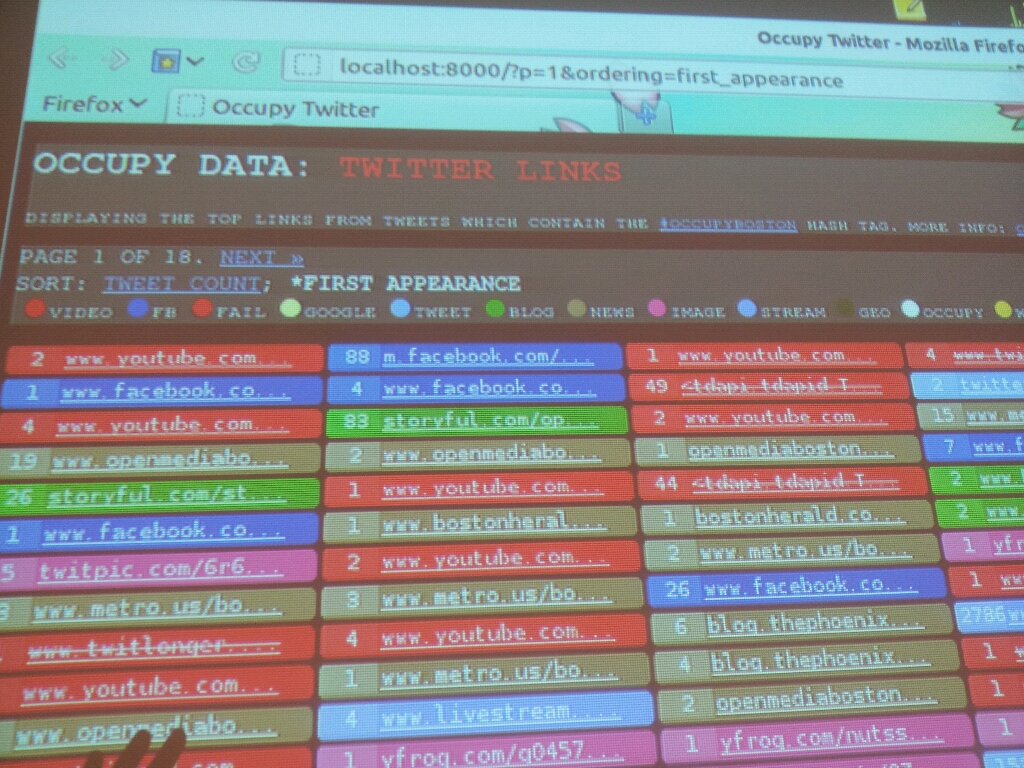 Fig. 10. The process to pull all the hyperlinks from OccupyBoston data was interesting. Here is the live visualization: Occupy Twitter 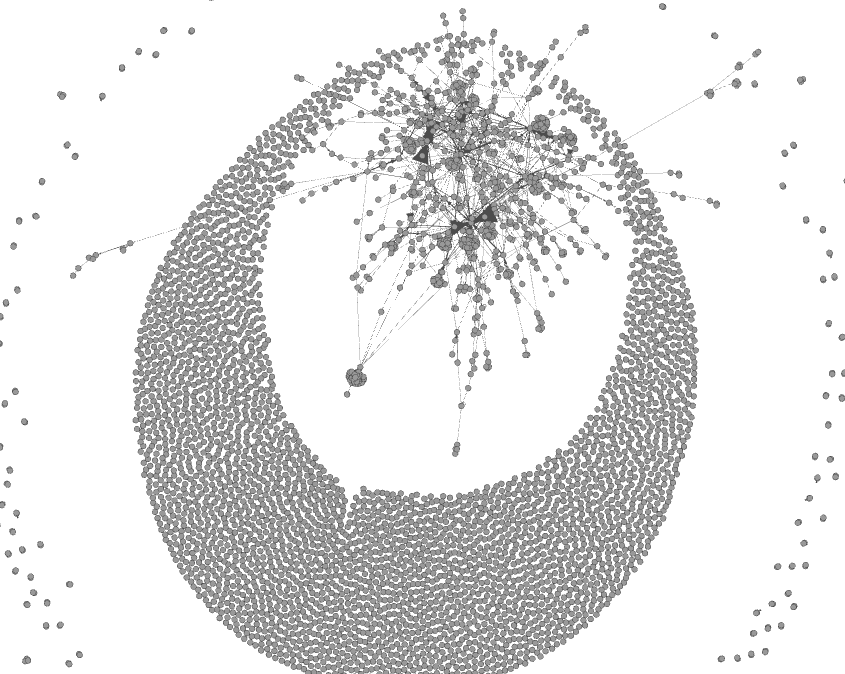 Fig. 11. Here Micha Cárdenas experiments for the first time with Gephi. This is a preliminary Gephi test graph of #OccupyAmsterdam tweets for #OccupyData, screencap while sorting tweets Twitter / micha cárdenas 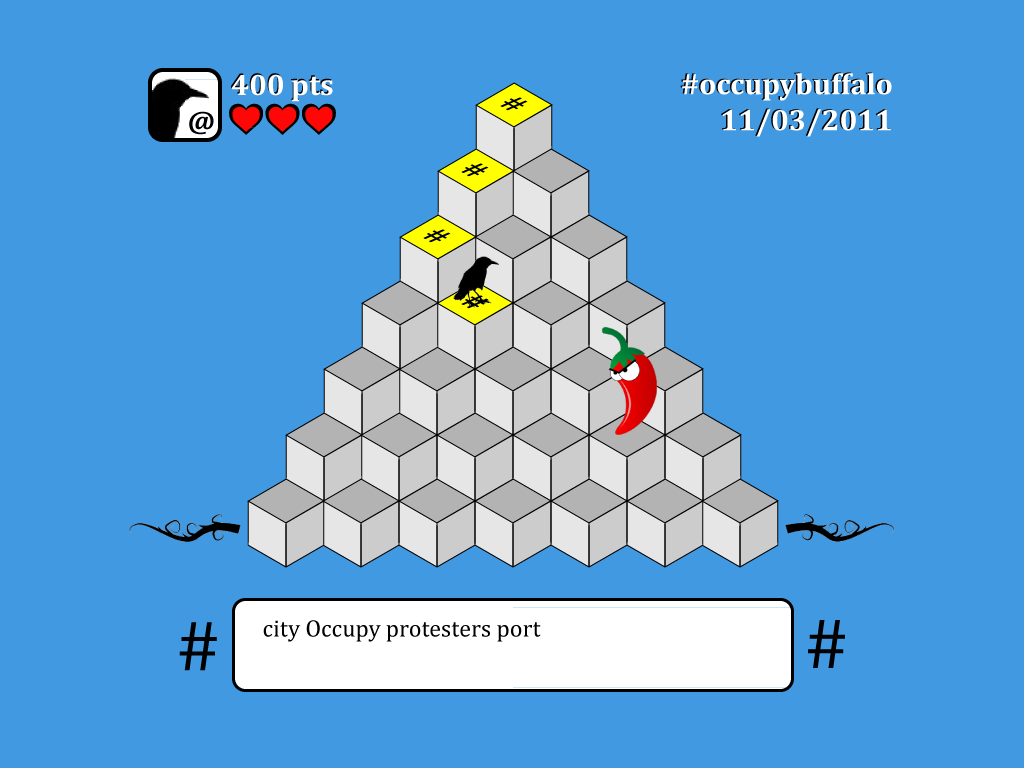 Fig 12. Concept art for #rustltd in-progress #OccupyData Hackathon game -- Twitter / Adam Liszkiewicz 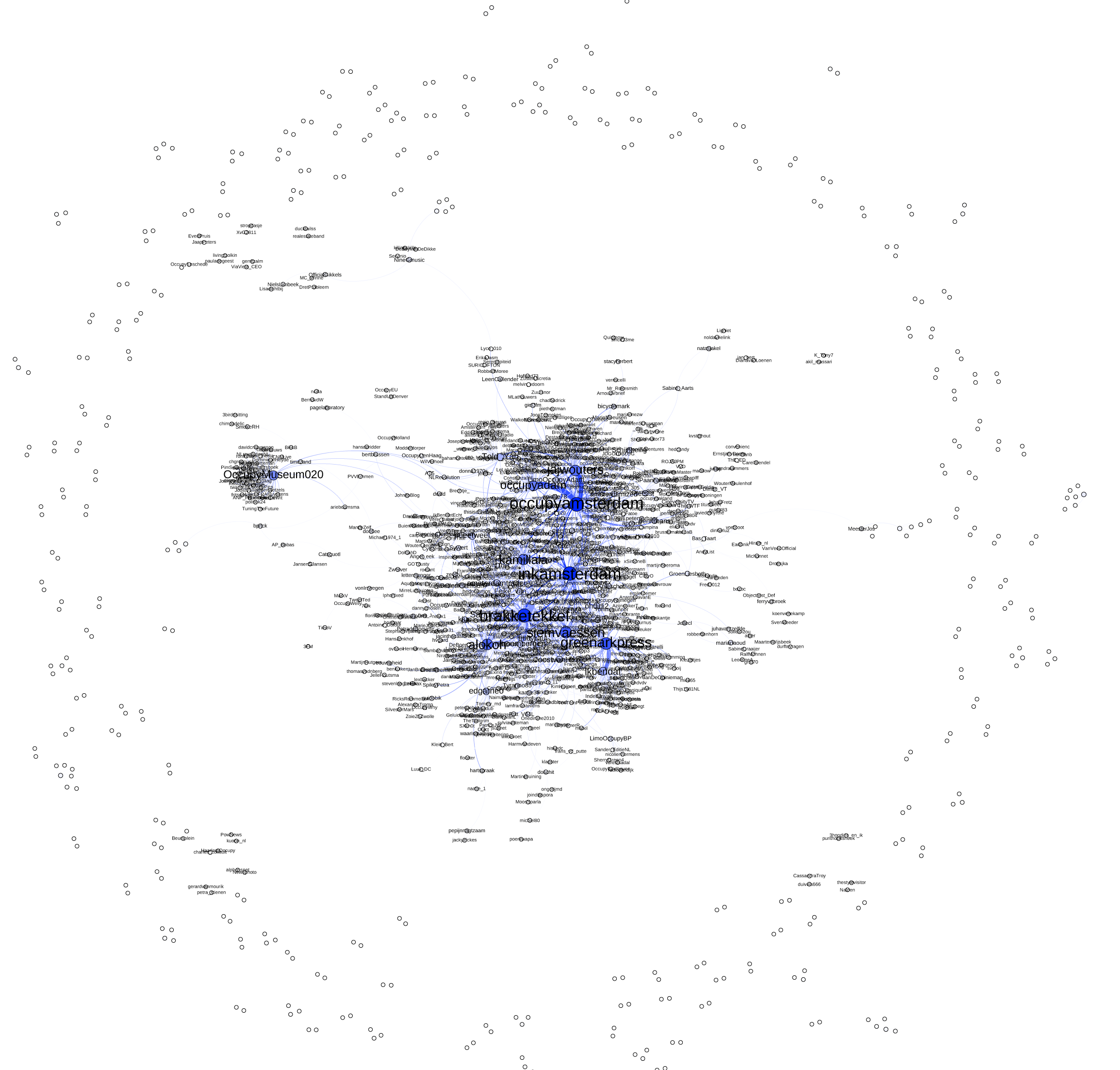 Fig 13. OccupyAmsterdam Gephi by Utrecht team. See their article, "#OccupyData Hackathon. Analysing millions of tweets." BEGINNING DAY 3 I am now on my way to the 3rd and final day of the hackathon. I am looking forward to seeing the final projects and to reading reflections and considerations on how we can do this better next time. This was a first step, a shot in the dark. Post-hackathon production will include a showcase of all the work and a written report of the event. Participants, please send us your submissions by midnight tonight! For questions, contact dan@r-shief.org or reference https://bit.ly/occupyhackathon. Stay tuned for more. In addition to documentation, check out this new exciting survey, which aims to create a better understanding of who engages with the Occupy movement, and how — it includes questions about media, communication, political activities, and more. VJ Um Amel Media Artist and Critic iMAP student at USC 2,430 views COMMENT(S) |
|
by: Ryanne The students of the master programme New Media and Digital Culture in Utrecht, The Netherlands are interested in data analysis and visualization. Popular platforms such as Twitter generate large amounts of data that can be scraped from the Internet. At the latest Future of Entertainment Conference in Boston we met Sasha Costanza-Chock who is affiliated with MIT's Civic Media Lab. Sasha is completely into researching the Occupy movement as it unfolds. Sasha pointed us to an upcoming hackathon on a large data set of Occupy tweets. Those had been scraped by R-Shief, a non-profit lab that collects large quantities of data. Among others R-Shief has a huge data set on Arab Spring related Tweets as well as on the Occupy movement. The Occupy dataset consists of over five million tweets containing Occupy related hashtags such as #occupyamsterdam #maspero, #occupyboston, #occupyfreedom and so forth. These huge samples constitute a great resource for analysis and visualization. Large data are a big challenge as well, and we are happy that the master programme New Media and Digital Culture will participate in the effort to make sense of the information provided in the data set. The upcoming 3-day hackathon is open for the general public. The organizers deliberately do not limit the participation to experts, but ask everyone to "join this collective act of re-imagining our relationship with Twitter data and the Occupy movement. OccupyData is meant to serve as an intervention by offering experts and activists means to work together and think critically about the movement, its messages, and goals and the role new media, and specifically, Twitter might play in this system." From Friday, December 9, 2011 through Sunday, December 11, 2011 teams around the globe will be working on analysing the data set. A live-stream connects the teams at location in Boston, Utrecht and Los Angeles as well as the many individual participants who have signed up for this exciting collaborative effort. The Utrecht team is headed by Ryanne Turenhout, an experienced Gephi tweaker and data scraper, supported by Thomas Boeschoten and Ruben Hazelaar. The team will gather at the SetUp Utrecht who generously host the NMDC team. As new media students we are interested in the ways new technologies are employed in organizing, communicating and framing socio-political issues. To what extent is Twitter a crucial tool in distributing information on Occupy? To what extent does Twitter serve as communication tool inside the occupy movement? What kind of social clusters and larger networks can we locate in the 'Occupy Twitter Sphere' and who are the important nodes in dispersing information, and how are the tweets related to established media? #OccupyData Hackathon Utrecht location: SetUp, Neude 5, Utrecht, The Netherlands. Friday 9 December - Sunday 11 December More Info: https://bit.ly/occupyhackathon or get in touch with the Utrecht team at @RyanneTKD This post was written by Mirko Tobias Schaefer and originally posted on newmediastudies.nl 392 views COMMENT(S) |
|
by: Laila Using network analysis and cultural analytics, panelist will present social media content on the “Arab Spring,” collected and analyzed on R-Shief.org since 2008. To defamiliarize our understanding of “Arab,” she will contextualize the extreme brutality in Bahrain, and the more popularized violent tactics of the Syrian regime, to the military complex in Egypt. If globalization is hyper-local, then how can visualizations of petabytes of media offer a window on different regional, national, and local practices? (VJ Um Amel) 365 views COMMENT(S) |
|
by: Farrah On this episode of the There is No Spoon show, we discuss the Occupy movement, which has spread from Occupy Wall Street to hundreds of towns and cities across the United States and the world in the past 1.5 months. Topics include: our own experiences with Occupy, police brutality at the protests, the movement's messages, macro and micro level impacts, and discussions about the movement's next steps. Hosted by Fouad Pervez, the No Spoon team of Joe Soler, Reggie Miller, Junaid Ahmad (joining us from Lahore), and Shahid Buttar (joining us from Oakland on the night of extreme police violence) welcome guests Al Butler and Annabel Park to the episode. Al is the host of the "Al B! in the Afternoon" radio talk show on WURD in Philadelphia, and Annabel is a founder and coordinator of the Coffee Party, an alternative to the Tea Party. Listen here: https://media24.podbean.com/pb/a0d89f...gEpisode10.mp3 Visit There is No Spoon Website here: There is No Spoon: Podcast Episode 10: The Occupy Movement 274 views COMMENT(S) |
|
by: Laila I am delighted to share with you that R-Shief is successfully reaching the science, art, and policy worlds at once. In a recent article in Science Magazine (published 9/30/2011), "Social Scientists Wade into the Twitter Stream," R-Shief is mentioned and one of our data visualizations is featured. For summary or to access the article, visit Science. 450 views COMMENT(S) |
|
by: Laila On August 20, 2011, R-Shief’s real-time Twitter mining revealed patterns and similarities in the visualization of the events in Zawiya and Tripoli. As journalists, activists, and scholars struggle to understand the last eight months of unprecedented mass mobilization and political upheaval in the Arab world, R-Shief is carving a unique and critical space in storing, processing, and analyzing information. Using its real-time analytic tools last weekend on its extensive repository of content from social media and other websites on the so-called “Arab Spring,” R-Shief Labs (henceforth Lab) produced timely, empirical analysis about the rebels’ military launch on Tripoli. And the accuracies in the conclusions prove to be quite interesting. 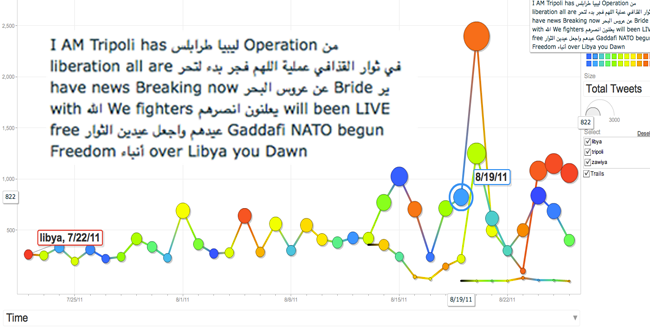 After months of rebel forces’ gains and losses across Libya’s territory, and the initial liberation of Benghazi with the help of NATO, it took the rebel forces only eighteen hours to finally take control of Tripoli's city center. On the one hand, it seemed a rapid turn of events. On the other hand, the rebels experienced major setbacks and committed errors of judgment. The setbacks included temporary loss of territory that they thought they had liberated; the error in judgment, or perhaps in the discipline of the forces and security control that they demonstrated, came with the announcement of the arrest and detainment of Seif al-Islam Qaddafi, the Libyan dictator’s son and putative heir. A short time later, he appeared on television to prove that if the rebels had captured him, he easily escaped and if they had not captured him, then they had made a public relations blunder. For months, NATO has been bombing key targets aimed to halt the abilities of Qaddafi’s military and his loyalists while the rebels barely made progress. It seems as if something changed radically allowing the rebels to make great strides, including taking the city of Tripoli, neighborhood by neighborhood. The announcement of the rebels taking control of Tripoli came fairly quickly, especially when one considers the many months that it took both the rebels and NATO to get to that point, processes that also including the beginnings of political recognition for the rebels’ government, the Transitional National Council (TNC). Placed on a larger time spectrum, Qaddafi held power for more than four decades in Libya but the actions that led to his marginalization took less than one year. It is as if Libyans’ fears diminished as they banded together and experienced rebel accomplishments. The power of political possibility demonstrated is incredible. A recent conversation with Liz Losh, professor at UC San Diego and author of VirtualPolitik, about R-Shief’s findings led to a useful reminder about the existing limitations of expression with regard to the “economics of social media.” Indeed, there are no definitive economic models to study the value of our associations, our temporality, or how to quantify things in the present.1 This absence cries out for examining emerging trends on large-scale datasets of social media. R-Shief’s mining and compilation of data aims to fill that gap by working among networked communities as a trustworthy commentator, a reliable source. As this article analyzes data mined from Twitter, examining its impact on Libya, Egypt, Oslo, or other global issues, a basic literacy about the nature of tweets is essential. Indeed, one of the goals of the Lab is to help non-experts be able to re-imagine their relationship to technology and gain a deeper understanding of the implications of using or choosing not to use technology. Social media and Twitter in particular have played a leading role in spreading and fomenting social uprisings, such as those witnessed in Egypt and Tunisia. It has quickly spread breaking news – in advance of news organizations – as demonstrated in the killing of Osama bin Laden. R-Shief’s recent analysis of tweets from Libya illustrates another facet of insight gleaned from social media: how certain everyday words can suddenly reflect a rising momentum of a rebel advance, or a global act of all kinds of media watching. In this article, I will explain how by using R-Shief’s tools to generate dynamic, interactive graphs within hours of events in Libya, one could see that it took basically twenty-four hours for the rebels to take over Zawiya – roughly from when the fighting began to when they captured the main square. Just as I had seen the words “now” and “began” appear in the word clouds generated from frequency counts from Thursday night tweets on Zawiya, I began to see those words appear in tweets on Tripoli. SOME GROUNDWORK BEFORE THE ANALYSIS Emerging from the fields of design research and performance art, R-Shief’s tools and methods are centered on a practice of “radical presentness.” Rather than approaching human behavior, and therefore, art, as mimetic2, R-Shief is conceived of through an understanding of human behavior as in a state of “becoming.” From this perspective, art does not imitate life, but rather, it takes on a double identity. This collapse of context can be understood theoretically, through the works of Deleuze and Guattari, specifically in their chapter on “Becoming-Intense, Becoming-Animal…” in A Thousand Plateaus: Capitalism and Schizophrenia, and among many other philosophers and artists, who have written on the nature of human experience and the telling of it as something that never quite begins, nor quite ends, but is in a constant state of becoming. In this case, R-Shief is designed to embody this in its code and machine intelligence. For example, in one line of code (represented in a “cron job”) the request to data mine Twitter, Facebook, blog, forum and website content is executed every two minutes. For purposes of doing comprehensive research and publication using R-Shief’s repository and analytic tools, the Lab has begun to build a taxonomy to explain both the nature of tweets and R-Shief’s dynamic database of tweets. The table below represents the communication logic of a tweet – its purpose, and how it happens. Each type of tweet – onlooking, coordinative, retweeting – behaves slightly differently. In the table below we have mapped out two behavior patterns – one, a tweets’ distribution among people, and two, the delivery time between when the tweet is sent and when it is received. Another way to explain how this works, from a design research approach, – is that Twitter is a space designed for others to create in. In order to understand that new world called Twitter, we must understand the rules of that world – even if temporality, erasability, and mutability are among those rules. This tweet taxonomy is designed to remain in development as data scientists and others provide us with even more insightful research on the meaning of Twitter. 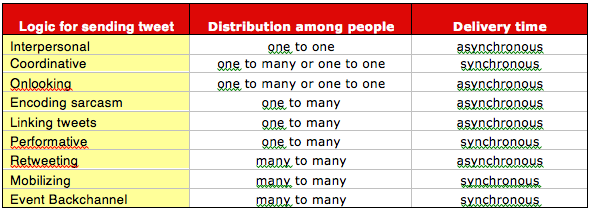 Fig. 1 Taxonomy of communicative logics of tweets In the case of #Libya tweets, since the very beginning, it is more likely that majority of people who are tweeting about #Libya are not in Libya. The clearest indication of that assumption, even before NATO’s interference, is that tweets in Arabic were coming in around 2,500 a day while tweets in English were coming in 20,000 a day. This is remarkable, especially when you compare them with tweets on #Egypt or #Syria in the graphs comparing two different below. 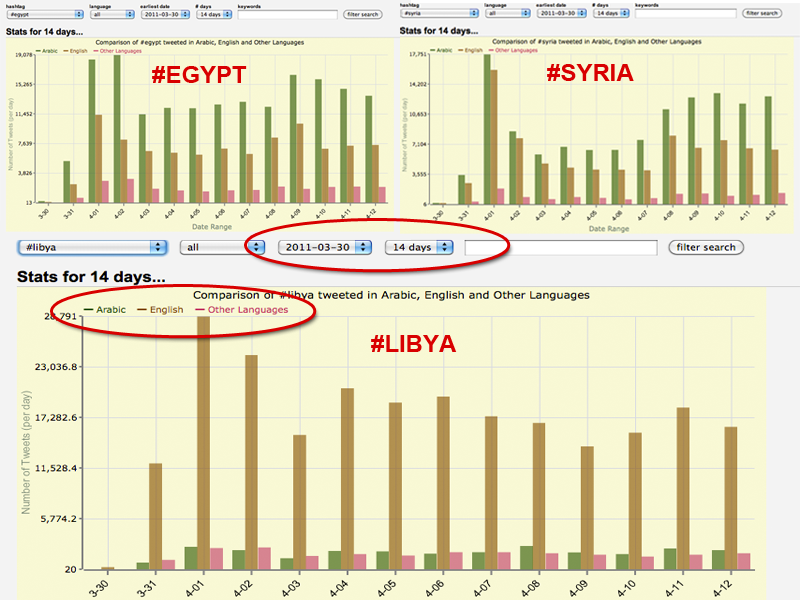 Fig. 2 R-Shief’s Twitterminer compares number of tweets of in Arabic (green) to tweets in English (brown) on #Libya with tweets on #Egypt and #Syria during the first two weeks in April 2011 when NATO took control of all military operations for Libya under United Nations Security Council Resolutions 1970 & 1973 on March 31, 2011. The graphs above did not fluctuate much since then (see Fig. 3). There has been a slight increase in Arabic tweets, but nothing indicative of a local population. It certainly seems that the people tweeting on #Libya are different from those tweeting on #Syria or #Egypt, where the phones and tweets are an integral part of organizing the rebellion. In many YouTube videos and images seen, Libyan rebels appear to carry AK47s rather than the cell phones of Egyptian regime opponents. One possible reading from this comparative analysis is that the people tweeting on #Libya are communicating a “voyeuristic” logic and perhaps “encoding sarcasm” and “linking media.” They are, thus, most likely not Libyans on the ground in Libya. 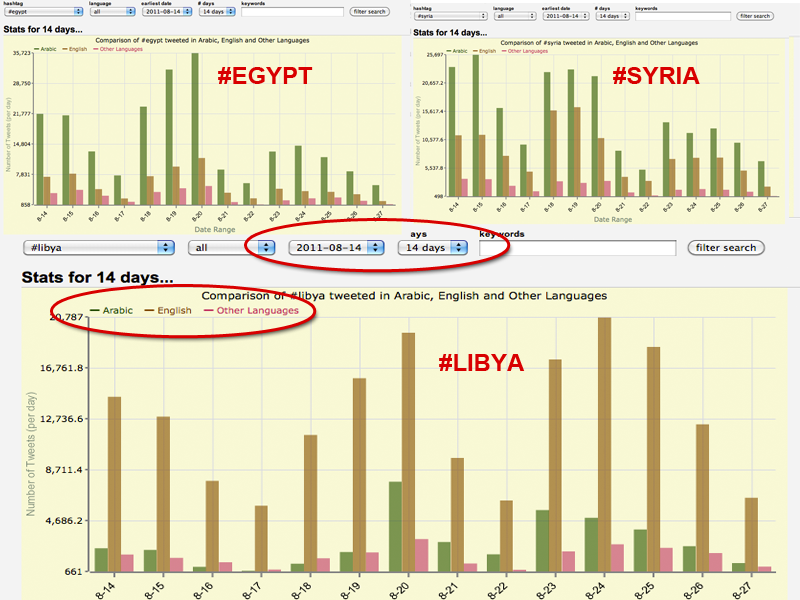 Fig. 3 R-Shief’s Twitterminer compares number of tweets of in Arabic (green) to tweets in English (brown) on #Libya with tweets on #Egypt and #Syria when rebels advance in Zawiya for over last two weeks in August 2011. Some analysis of the population sample is required to gain a deeper understanding of who is tweeting and how that contributes to the spread of information. Ultimately, R-Shief relies on Twitter’s public API (not Twitter’s private, $32,000/month pipe called the “gnip”) for its main source; since we cannot know how much of a sample the public API is out of the complete corpus from Twitter, the analyst detects a limitation in the data, much like a box or a series of boxes being missing from a historical archive. That being said, most researchers conduct analysis of tweets only using Twitter’s API because of the costly nature of the full pipe, though it is not always made explicit. Twitter also imposes a restriction: it has set a download limit of 1,500 tweets for each pull, and users can only access up to the previous 7 days of tweets. This is a critical point. In order to do any in-depth analysis of tweets, one needs a history of the population sample. By providing an archive of tweets going back as far as 2010, R-Shief offers the research community a tremendous resource. R-Shief’s system is designed to automatically pull up to the maximum allotted tweets every 2 minutes and save them onto its cloud computing network. For over a year, this unique data mining design far surpasses the mining of over 175 Twitter feeds every 2 minutes, making R-Shief’s archive of Twitter’s public API one of the most extensive and thorough repository of tweets on the Middle East publicly available. As for the tweet itself, it is comprised of 140 alpha-numeric characters, produced by an individual using either a text enabled phone or a computer. And these tweets can be organized by hashtag (a sort of “channel”) by adding a “#” in front of a group of characters (usually, a word). This is done in order for meta-data, such as geo-tagging, to be embedded in the stream of tweets identifying tweeters’ chosen identifier when they make their postings. Accurate geo-location is rare as very few users allow for geo-tagging, which requires user permission. There is a popular assumption, however, that when people are tweeting, they are tweeting what is happening in the moment around them in real time and space. R-Shief Labs has built a swarm computing system, Twitternommer, which basically runs Twitterminer and enables researchers to filter and export data on the command line. It is a type of machine learning of various languages used in Twitter. As of now, Twitternommer is building a lexicon of Twitter in Arabic, English, French, Spanish, German, and Farsi character by character. It also parses out the retweets, other hashtags, and users mentioned in the tweets. It removes all extraneous characters (such as html tags, links, and headers) and creates a semantic word cloud analysis. This data can be analyzed by the hour and by the minutes. Twitternomer provides real-time analysis of R-Shief’s entire repository. CASE STUDY: COMPARATIVE ANALYSIS OF #LIBYA TWEETS ON ZAWIYA AND TRIPOLI Friday, 8/19/2011 7:55pm Los Angeles time/ 4:55am Zawiya time: R-Shief received an SMS that the rebels had won over Zawiya, a key city near the Mediterranean coast in Libya only 30 miles west of the capital, Tripoli. This message signaled to R-Shief Labs to start analyzing its data to see if online information could add insight into the unprecedented events in Libya. The analysis conducted over the next couple days on tweets about #Libya illustrates another facet of insight gleaned from social media: how certain everyday words on a social media platform suddenly seem to reflect the rising momentum of a rebel advance. 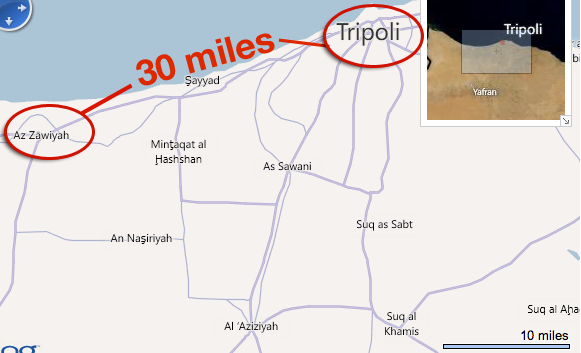 Fig 4. Map of northwestern coastline of Libya from National Geographic. Saturday, 8/20/2011 2:00pm Los Angeles time/ 11:00pm Zawiya time: The first step in the process of analyzing what was happening in Libya through real-time social media was to export a history of R-Shief’s tweets on #Libya from March 30, 2011 through the present. The graphs reveal interesting patterns and disruptions to the baseline data of R-Shief’s database on #Libya from March 30, 2011. The number of tweets per day grew to similar activity levels as early on in the mass mobilization efforts in Libya in the spring. And, even more noticeably, the number of channels, or hashtags, increased exponentially over the last ten days in August 2011. Fig 5. Interactive graph of daily frequency of #Libya tweets: March 30, 2011 - August 25, 2011 Saturday, 8/20/2011 4:20pm Los Angeles Time/ 1:20am (next day, Sunday) Tripoli time: A few hours later same day, Saturday, the rebels had advanced to Tripoli and the fight for the nation’s capital. To compare the tweets on Tripoli with those on Zawiya within the #Libya corpus of data, I first conducted keyword search to filter out Zawiya and Tripoli tweets from the same population sample. 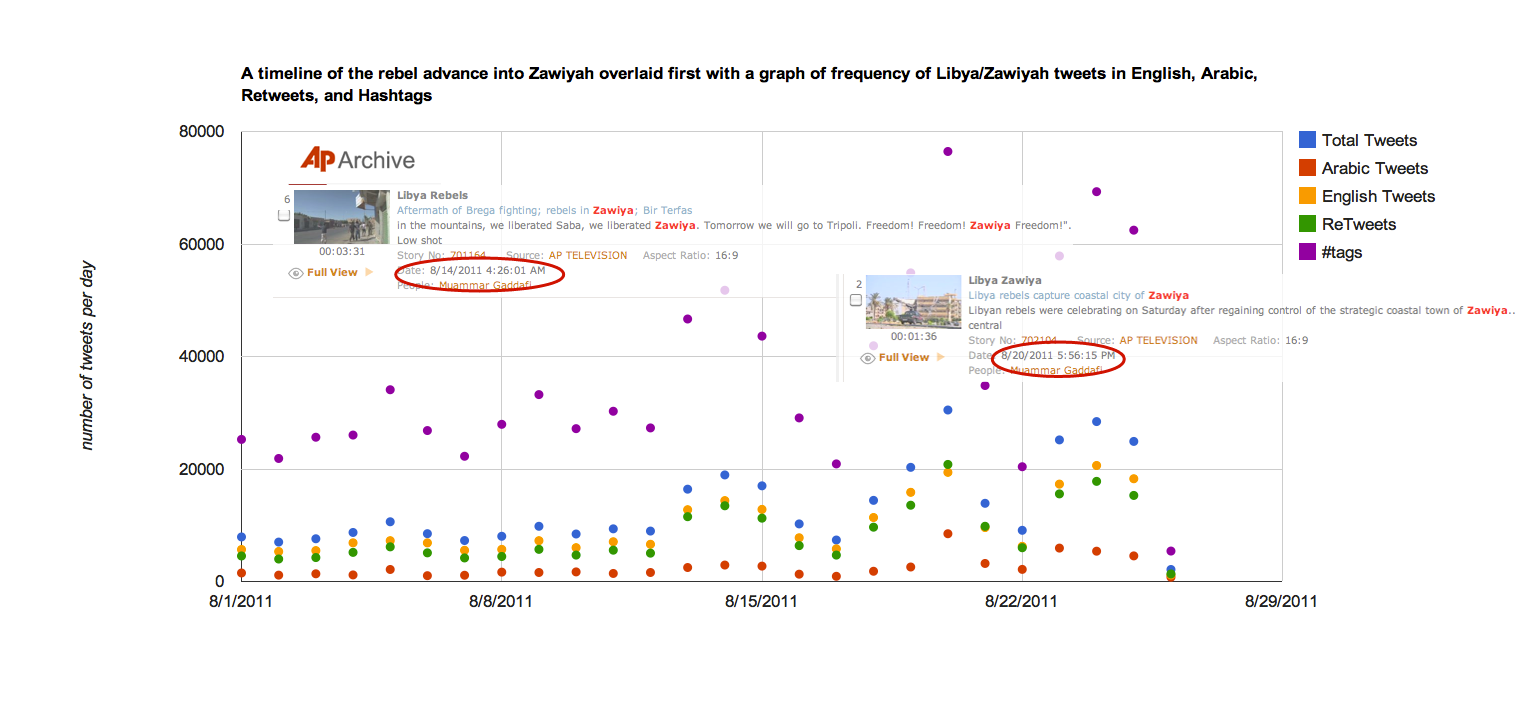 Fig 6. A timeline of the rebel advance into Zawiya overlaid with graph of frequency of Libya/Zawiya tweets in English and Arabic, as well as Retweets and Hashtags. Fig 7. Interactive graph includes a timeline with a play button at the bottom, and three different tabs at the top. If you hover over the word clouds, they will change when timeline is played. In this dynamic, interactive graph, I was able to see that it took basically twenty-four hours for the rebels to take over Zawiya – roughly from when the fighting began to when they captured the main square. See the steep peak with the orange, word cloud circle at the top. Just as I had seen the words “now” and “began” appear in the word clouds generated from frequency counts from Thursday night tweets on Zawiya, I had begun to see those words appear in tweets on Tripoli. It took forty minutes to process gigabytes of tweets data, visualize and analyze it. And so R-Shief sent out a text message to its mobile subscribers: “Doing analysis on R-Shief’s tweets – prediction is Tripoli will fall in next 18-36 hours! And [potentially] will affect Syria and Yemen.” 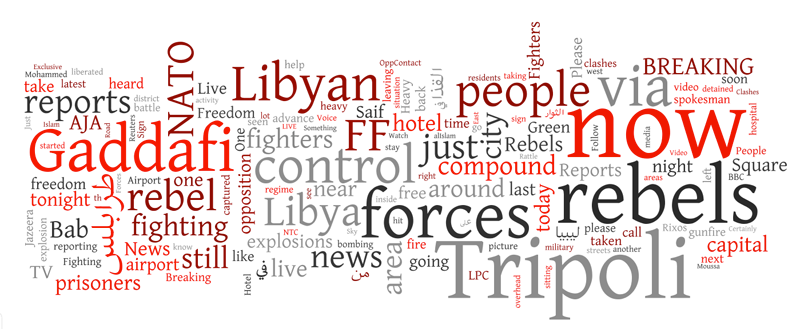 Fig 8. Word count of most frequent words tweeted on #Qaddafi from 8/18/2011-8/22/2011. Sunday, 8/21/2011 5:00pm Los Angeles Time/ 2:00am (next day, Sunday) Tripoli time: And indeed, eighteen hours later, Al Jazeera, Facebook, and Twitter were broadcasting that Mohammed Qaddafi (eldest son) surrendered; Seif Islam had been captured (but later on Monday, there were claims he was checking into a hotel); and that al-Senussi, the head of intelligence, had been assassinated. Days later, the fighting in Tripoli continues, however, clearly things are changing.  THE FUTURE: R-SHIEF AND ITS DYNAMIC ROLES Oriented in this unique approach, R-Shief is able to harness the liminal space between groups of people trying to deal with archival material and digital repositories on the Middle East. Some groups work to make sense out of them through traditional scholarship, such as historians or digital humanities pedagogues. These scholars might approach R-Shief as a repository of data from social media on the “Arab Spring” and the Middle East region, overall, that offers the possibility of qualitative evidence. At the same time there are researchers, policy makers, businesswomen who could gain a competitive edge using a potential forecasting tool to read the global pulse of Twitter. The work has just begun. As I mentioned at the outset, in order to consider social media as a platform to forecast on the ground events, we must have a better understanding of the economics of social media. What is going on the ground throughout the Arab world is both unprecedented, and ultimately unpredictable. The reality is that R-Shief mediates between both worlds. Article and data visualizations by VJ Um Amel. Data mining by Ian Jones. This is an R-Shief Labs project. ---------------- 1. In response, a growing number of metaphors around virtual economies of time and value are rapidly emerging – such as attention economy, the distraction economy, the reputation economy, etc… -- building social capital through virtual identities. For example, Ian Bogost talks about membership (giving up data about yourself) versus licensed economies online. 2. Aristotle talks about art as mimesis and describes in great detail the mimetic act. So does that mean that work that is not mimetic, but about embodying, not considered as art by all? 6,181 views COMMENT(S) |
|
by: salty As rebels surround Libya’s capital city of Tripoli, widespread tweets are claiming Libyan leader Colonel Muammar Al-Gaddafi has left the country. So far, NBC correspondent Richard Engel reports via Twitter that “people are celebrating … still lots of gunfire … but reports from here in Libya still unconfirmed.” Follow the tweets at #Libya — here’s the link: رشيف | Twitterminer 383 views COMMENT(S) |
|
by: Ursula DESIGNING CIVIC ENCOUNTER SYMPOSIUM . WORKSHOP . TOUR JULY 21 – 24, 2011 SHAREK YOUTH FORUM, RAMALLAH Curated by Shuruq Harb and Ursula Biemann ArtTerritories With Yazid Anani, Shumon Basar, Taysir Batniji, Suhad Bishara, Teddy Cruz, Rami Daher, Hangar, Alessandro Petti, Ahmad Saleh, Muhammad Shtayyeh, Omar Yousef.  DESIGNING CIVIC ENCOUNTER is a series of interventions engaging in existing and potential forms of urban development and public culture. The event will unfold through a bus tour traversing urban locations within and around Ramallah city enabling debates and conversations at different stations, a two-day symposium on questions of urban transformations in Palestinian and other Arab cities, and a full day workshop with visionary social architect Teddy Cruz. Inspired by dialogues on ArtTerritories‘ website and by the wider civic movements in the region, ArtTerritories proposes an open forum for the inquiry and discussion of the public urban experience under the current trends in planning, financing and building practices. Although Ramallah is a relatively small city, it has experienced radical urban expansions and population growth since the signing of the Oslo Accords in 1993 and the consequent establishment of the Palestinian Authority in 1996. Real Estate is the main target for foreign corporate investment today. What kind of living space do these investments create? The bus tour will highlight a number of distinctive urban landscapes that can be considered emblematic of wider political issues taking place in Palestine. In a close reading of contemporary urban restructuring in the region, the symposium brings to light that the Palestinian context is not as unique and isolated as it may appear but in fact shares many commonalities with rapid developments in Beirut, Amman and Dubai. The project is conceived as a vibrant multimedia laboratory of ideas and debate. During four days, the city will be under investigation through cultural and artistic initiatives, innovative research projects and political visions. Attracting an active local and international roster of architects, artists, educators, environmentalists, community activists and politicians, the public event hopes to be a catalyst to produce new civic imaginations and alternative urban policies towards a more inclusive social sustainability. A digital publication will be made available at ArtTerritories at a later date. The project is initiated and produced by ArtTerritories, online publishing platform for Art and Visual Culture in the Arab World co-founded by Shuruq Harb and Ursula Biemann. English and Arabic / Free Admission The project is generously funded by Rosa Luxemburg Foundation and the bus tour is sponsored by Riwaq For more information or if you wish to receive the program folder, please contact info@artterritories.net 849 views COMMENT(S) |
|
by: Laila Having just presented at The Access to Knowledge for Development Center's (A2K4D) second annual workshop at AUC's Tahrir Campus in Cairo, Egypt on June 14, 2011, R-Shief Project Lead Laila Shereen Sakr (aka VJ Um Amel) and R-Shief are generating a lot of interest this last week in June....
994 views COMMENT(S) |
|
by: Laila I have just returned from a two-week trip to Cairo, Egypt where I was invited by the Access to Knowledge for Development Center at the American University of Cairo to participate in their second annual conference on "Democratizing Knowledge." The trip was super productive and I met with several initiatives in Egypt working towards building a new Egypt - free from corruption and democratic from the ground up. On Sunday, 26 June 2011, I was invited to participate on a panel on "Al-Sha’ab Yureed" (The People Demand): Transmitting the Revolution." And so I sent them this VJ Remix of my talk at the #A2K4D conference. For more information at VJ Um Amel, R-Shief, and her recent work on the Arab Spring, see recent reviews and media coverage: VJ Um Amel hits ‘the social’ in media | Al-Masry Al-Youm: Today's News from Egypt by Lina Attalah 779 views COMMENT(S) |
|
by: Laila FOR IMMEDIATE RELEASE: Los Angeles, CA, June 10, 2011 — The new R-Shief.org site provides real-time analysis of opinion in the Arab world about late-breaking issues. R-Shief uses an interactive map to allow users to slice through aggregate web, Facebook, Twitter, and other data in order to analyze what Arabs are saying about the issues that impact them. Users can see which posts are gaining the most traction and which topics are dominating the chatter on Twitter and Facebook. R-Shief provides this analysis by sorting through thousands of Twitter feeds and other sources and using multiple search criteria to determine the most talked-about topics and issues. The site also parses this data in order to produce visual representations that help untangle the different threads of the social conversation taking place in Egypt and elsewhere. A series of sentiment and semantic analyses are being produced for future release. “There has been a fundamental societal shift in the role of media in Egypt and other Arab nations during the Arab Spring protests,” said Laila Shereen Sakr, Project Lead of R-Shief. “For the first time, media in Egypt and other Arab countries is tracking what citizens are actually saying and doing, instead of repeating an official government line. R-Shief is a tool that enables critical investigation and study of this phenomenon.” R-Shief, based in Los Angeles, also publishes a regular blog on various issues concerning Arab culture, media, critical code and other interdisciplinary research questions. This multilingual site promotes an exchange of ideas and reviews of places for research in the Middle East for scholars, journalists and artists traveling to the region. It also serves as a social networking hub for its users. R-Shief.org has already generated a strong buzz in academic, technical, artistic and political circles. Recent articles on its work have appeared in The Wall Street Journal’s MarketWatch, ThoughtMesh, and the Parson’s Journal for Information Mapping, among others. In addition, Sakr has presented her concept at Facebook, Cornell University, the Middle East Studies Association, and the Arab Techies workshop in Beirut, Lebanon. Sakr’s data visualizations have been shown at the “interACTIVATE” exhibition at the Santa Cruz Museum of Art and History. In addition, the concept of combining Twitter analytics and data visualization earned R-Shief a third-place win in the 2011 CRUNCH Design Challenge at USC’s Annenberg Innovation Lab, as well the American-Arab Anti-Discrimination 2009 Media Scholarship Award. “R-Shief” is the Arabic word for “archive.” For more information about us: /about 1,659 views COMMENT(S) |
|
by: Laila Critical Code Studies (CCS) is an emerging field overlapping multimedia literacy, software studies, media forensics, and platform studies as a new approach for socio-historical analysis. Expert, Mark Marino, asserts that CCS asserts that lines of code are not neutral. Rather, their physical architecture creates a "filter" through which information is funneled, adding an additional layer of complexity and interpretation. R-Shief’s goal is to build this community. Critical Code Studies encompasses a relatively new field of study. Its approach applies the theory and practice of interpretation to computer code, program architecture, and digital documentation within a socio-historical context. CCS follows the work of Critical Legal Studies, in that its practitioners apply theory to a functional document (in this case a computer program) to explicate the meanings embedded and implicated in the document beyond the aspect of function or affordability. The goal of CCS is to unearth the many implicit and explicit meanings undergirding a work of computer or digital code. 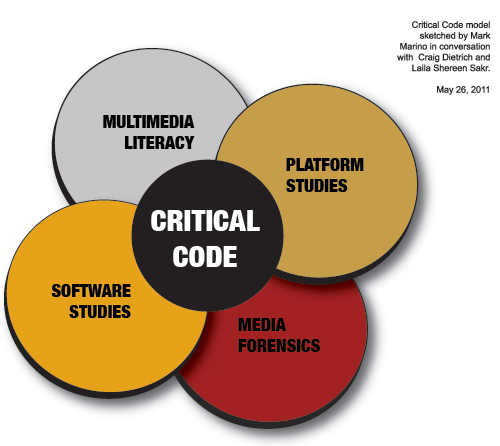 Meaning is typically assessed through the application of a human (language-based) filter. However, in the last few years, a paradigm shift has focused attention on the effects of a technically-mediated filter. For example, we might now ask “how does the structure of the database impact the meaning that is available through data-mining practices?” This is a different kind of question than “what are the frequencies of the appearance of certain words within the database?” This shift sets the stage for a careful consideration of the importance of procedural literacy among those who use and create knowledge in the interactions between humans and technological network structures. An example of this cultural shift is that, despite media evidence to the contrary, there is a popular current misconception that Osama Bin Laden was not actually killed by U.S. forces, and that the current U.S. Administration is spreading rumors of his death to gain momentum for the upcoming presidential election. In addition, the “Birther Movement” has created doubt regarding the birthplace of U.S. President Obama, even though copies of his birth certificate proving that he was born in Hawaii have been published in “credible” media outlets like Newsweek. Increased transparency and the democratization of media outlets have resulted in multiple contradictory and equally publicized stories. The lack of perceived checks and balances of information available on the Internet have reduced the public’s confidence that what they are hearing and seeing as “news” is in fact accurate and trustworthy. This shift sets the stage for a careful consideration of the importance of procedural literacy among those who use and create knowledge in the interactions between humans and technological network structures. Technological structures are complicated and have many layers of coding and recoding to be properly understood. Another way of understanding code is as mental processes. In this work, R-Shief opens up an entire window to what counts as knowledge and cultural production on the contemporary Middle East. 929 views COMMENT(S) |
|
by: Laila The Netherlands-Flemish Institute in Cairo is delighted to send out a call for papers for a three-day conference on "Islam, Citizenship and the New Media in Pre- and Post-Revolutionary Egypt", to be held in Cairo on 18-20 December 2011. Within the framework of the research programme ‘Strengthening knowledge of and dialogue with the Muslim world’, in short Islam Research Programme (IRP), funded by the Dutch Ministry of Foreign Affairs, the NVIC project originally took Islamic preaching in the new media in Egypt as its subject, with an initial focus on the various communication strategies developed by competing Islamic actors. In the course of this (still ongoing) research, new perspectives arising from our findings, as well as changes in focus brought about by the 25th January revolution, broadened our approach to the central question of Islamic discourse. Its relation to issues of citizenship - understood broadly as a sense of identity, as a sense of belonging to a community, and as a capacity, that of producer-consumer of culture - in present-day Egypt has become more topical, and we invite you to explore this together. For more information: Islam, Citizenship and New Media in Pre- and Post-Revolutionary Egypt | Digital Islam 963 views COMMENT(S) |
|
by: Laila In addition to connecting an on-line community, R-Shief archives and aggregates online videos, Twitter, Facebook, satellite TV, online journals, and data visualizations. During the Egyptian and Tunisian revolutions, media makers became “co-designers” of the transformative, speedy, historic event(s) in the region posts on Twitter, to the roles of Facebook, YouTube, Al Jazeera, Democracy Now, to White House and Egyptian State Television broadcasting. The Arab Spring was brought on not only by large numbers of Egyptians were flooding the streets of Egyptian cities throughout the country, but by the impact of an additional filter of pedabytes of data mediated through various networks. This layer of media created a paradigm shift whose. The speed and impact of information and ideas would not have been achieved through human movement or transformation alone. Twitter Analytics by #Hashtag from VJ Um Amel on Vimeo. Since August 2010, R-Shief has been data mining (pulling from Twitter and storing onto its own server every 15 minutes) tweets by selected hashtags. (A hashtag is Twitter nomenclature for 'subject heading'). After storing the tweets by hashtag, the data is sorted by language field because language is able to offer culturally specific indicators of the Middle East beyond its current geopolitical place in the world. R-Shief started by adding #Tunisia, then #Jan25 to the existing Twitter Analytics on January 25, 2011. Despite what some scholars and journalists might have said before, Twitter (and other social networking sites) had undoubtedly been causal in recent events in the Middle East. Effectively, R-Shief continues to make accessible all tweets following hashtags: #Wikileaks, #Tunisia, #Jan25, #KhaledSaid, #Abdulemam, #Gaza, and #Flotilla going as far back as September 2010. This simple, craigslist-like interface is meant to encourage users to filter searches through these hashtags by language and/or range of dates, while providing interesting word clouds and parsing out top contributors and hyperlinks within tweets. R-Shief’s role as a purely academic aggregator was put to use as an artistic incubator when Laila Shereen Sakr–-using her moniker, VJ Um Amel--crafted a VJ remix in support of her fellow Egyptians incorporating media data from the R-Shief site. Her video "#Jan25, Oum Kalthoum, Sadat, Latuff, #Video Remix" (“Jan 25 Remix”) was published on both Vimeo and YouTube on Monday, Jan 31, 2011, one week into the protest in Egypt. #JAN25 remix by @vj_um_amel 4 #Egypt from VJ Um Amel on Vimeo. Through VJ Um Amel’s research developing R-Shief Twitter Analytics, over 800,000 tweets on the hashtag #Jan25 alone have been accumulated since Jan 25, 2011, including several days at the height of the conflict in Egypt, when 21 million inhabitants in Egypt were cut from their Internet lines and almost half the population (82-85 million) were deprived of their mobile phone services. Still the world tweeted. How did that happen? How were millions of tweets generated over protests in Egypt while the entire nation was offline? She wrote about her experience managing this Twitter aggregation in a recently published article in critical code journal, ThoughtMesh: "social media operates based on principles of uncertainty, where there are no groups, only formations of groups, and where non-linear time and space still create narratives and meaning vis-à-vis the database, and where objects (such as Twitter) have agency in a social network." (ThoughtMesh.net, February 5, 2011). Semantic Content Analysis of 800,000 #Jan25 Tweets from VJ Um Amel on Vimeo. The purpose of these data visualizations is to capture that special eruption that suggests Twitter (and other social media sites) own special possibilities that are potentially subversive and feared by government to the extent they shut down the Internet to an entire nation during mass protest. This next information visualization below, also published Feb 12, 2011, was designed to have a more poetic (and less narrative) meaning to express, poet in this context refers to . This is a running hashtag of all the tweets on #Egypt that were posted to Twitter the day Hosni Mubarak resigned as president of Egypt. Whereas the previous semantic content info vid is more like content analysis or data visualization, the hashmap presented here offers a sentiment analysis and is intended to be evocative. The ecology in the field of database narrative making and visualizing is undoubtedly a rich, undiscovered territory to explore. In parallel, her itch to create innovative VJ mixes continues. They are a version of blog posts, a type of serialized commentary. Common among the creative fields--the arts, science, technology and design--is a commitment to the production of new knowledge based on original research. What the World Tweeted on #Egypt the day Mubarak Resigned from VJ Um Amel on Vimeo. In conclusion, there was a fundamental societal shift in Egypt during the Arab Spring protests, when media became actively dependent on the social fabric in Egypt, rather than institutional sources of information and analysis. VJ Um Amel asserts that there is a need to consider various methodological approaches to social media analysis for both the expert and the student. Social media in the Arab world is unique--both in terms of how the society is using it, and in terms of media's history in the Arab world. Where U.S. media, in principle, acts to ensure the power of the government remains under checks and balances, in the Arab world it functions generally as an apparatus of the state rather than a form of societal self-expression. Social media and its surprising political usages have created interplay between the application of structure and resistance that have been transformative in Arab countries during the Arab Spring Protests. VJ Um Amel researching extended notions of how innovative methods might be applied in a Media studies or Middle East studies context. 388 views COMMENT(S) |
| About Us | |
| We are a community-driven platform of critical code experts and researchers working on the Middle East. The goal is to promote procedural and digital literacy by providing a research & development platform for innovative knowledge production on the Middle East. We believe that procedural literacy provides a key to 21st century democratic practices. | |

|
|
Top contributors
| |
12 | |
3 | |
2 | |
1 | |
1 |
Top Replies |
Recent Activity |
| ARCHIVE |
|
|